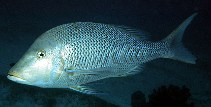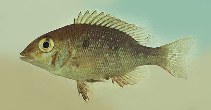把你的觀察加入 Fish Watcher
| Native range | All suitable habitat | Point map | Year 2050 |

|
| This map was computer-generated and has not yet been reviewed. |
| Lethrinus nebulosus AquaMaps Data sources: GBIF OBIS |
Saudi Arabia country information
Common names:
Shaoor mehseny, Sheiry, إمبراطور مُبرَّق
Occurrence: native
Salinity: marine
Abundance: | Ref:
Importance: | Ref:
Aquaculture: | Ref:
Regulations: | Ref:
Uses: no uses
Comments:
National Checklist:
Country Information: https://www.cia.gov/library/publications/resources/the-world-factbook/geos/sa.html
National Fisheries Authority:
Occurrences: Occurrences Point map
Main Ref: Carpenter, K.E. and G.R. Allen, 1989
National Database:
Occurrence: native
Salinity: marine
Abundance: | Ref:
Importance: | Ref:
Aquaculture: | Ref:
Regulations: | Ref:
Uses: no uses
Comments:
National Checklist:
Country Information: https://www.cia.gov/library/publications/resources/the-world-factbook/geos/sa.html
National Fisheries Authority:
Occurrences: Occurrences Point map
Main Ref: Carpenter, K.E. and G.R. Allen, 1989
National Database:
Common names from other countries
分類 / Names 俗名 | 同種異名 | Catalog of Fishes(屬, 種) | ITIS | CoL | WoRMS | Cloffa
Teleostei > Eupercaria/misc (Various families in series Eupercaria) 鱸形目 (Various families in series Eupercaria) > Lethrinidae (Emperors or scavengers) 裸頰鯛科 (Emperors or scavengers) > Lethrininae
Etymology: Lethrinus: Greek, lethrinia, a fish pertaining to genus Pagellus.
More on author: Forsskål.
Etymology: Lethrinus: Greek, lethrinia, a fish pertaining to genus Pagellus.
More on author: Forsskål.
Environment: milieu / climate zone / depth range / distribution range 生態學
海洋; 半鹹淡水 礁區魚類; 非遷移的; 深度上下限 10 - 75 m (Ref. 2295). 熱帶; 34°N - 34°S, 25°E - 170°W
分布 國家 | FAO區域 | 生態系 | 發現紀錄 | Point map | 簡介 | Faunafri
Indo-West Pacific: Red Sea, Persian Gulf and East Africa to southern Japan and Samoa. According to a genetic study (Ref. 28017), Lethrinus nebulosus and Lethrinus choerorynchus are two distinct species in Western Australia.
印度-西太平洋: 紅海 , 波斯灣而且東非到日本南部與美屬薩摩亞。 根據一個遺傳的研究 (參考文獻 28017), 青嘴龍占〔Lethrinus nebulosus〕 ,而且 藍帶裸頰鯛〔Lethrinus choerorynchus〕 在西澳大利亞是二個不同的種。
印度-西太平洋: 紅海 , 波斯灣而且東非到日本南部與美屬薩摩亞。 根據一個遺傳的研究 (參考文獻 28017), 青嘴龍占〔Lethrinus nebulosus〕 ,而且 藍帶裸頰鯛〔Lethrinus choerorynchus〕 在西澳大利亞是二個不同的種。
Length at first maturity / 大小 / 重量 / 年齡
Maturity: Lm 38.8, range 41 - ? cm
Max length : 87.0 cm TL 雄魚/尚未辨別雌雄; (Ref. 47613); common length : 70.0 cm TL 雄魚/尚未辨別雌雄; (Ref. 5450); 最大體重: 8.4 kg (Ref. 40637); 最大年齡: 28 年 (Ref. 92312)
Max length : 87.0 cm TL 雄魚/尚未辨別雌雄; (Ref. 47613); common length : 70.0 cm TL 雄魚/尚未辨別雌雄; (Ref. 5450); 最大體重: 8.4 kg (Ref. 40637); 最大年齡: 28 年 (Ref. 92312)
簡短描述 檢索表 | 型態特徵 | 形態測量圖
背棘 (總數) : 10; 背的軟條 (總數) : 9; 臀棘: 3; 臀鰭軟條: 8. This species is distinguished by the following characters: body moderately deep, its depth 2.5-2.9 times in standard length; head length 0.9-1 times in body depth, 2.6-3.1 times in SL, dorsal profile near eye nearly straight, or in large individuals, distinctly concave; snout moderately long, its length about 1.8-2.4 times in HL, measured without the lip the snout is 0.8-1 times in cheek height, its dorsal profile nearly straight or concave, snout angle relative to upper jaw between 50° and 68°; interorbital space usually convex; posterior nostril an oblong longitudinal opening, closer to orbit than anterior nostril or, about halfway between orbit and anterior nostril eye not close to dorsal profile except in small individuals, its length 3.6-5.9 times in HL; cheek moderately high, its height 2.4-3 times in HL; lateral teeth in jaws rounded with points or molars that often have tubercles; outer surface of maxilla smooth or with a longitudinal ridge; D X, 9 with the 4th or 5th dorsal-fin spine usually the longest, its length 2.7-3.6 times in body depth; A III,8 with the first soft ray usually the longest, its length almost equal to or slightly shorter than length of base of soft-rayed portion of anal fin and 1.3-1.6 times in length of entire anal-fin base; pectoral-fin rays 13; pelvic-fin membranes between rays closest to body usually with dense melanophores; cheek without scales; 46-48 lateral-line scales; 5 ½ scale rows between lateral line and base of middle dorsal-fin spines; 16-17 scale rows in transverse series between origin of anal fin and lateral line; usually 15 rows in lower series of scales around caudal peduncle; 5-9 scales in supratemporal patch; inner surface of pectoral-fin base densely covered with scales; posterior angle of operculum fully scaly. Colour of body yellowish or bronze, lighter below, centers of many scales with a white or light blue spot, sometimes irregular dark indistinct bars on sides and a square black blotch above pectoral fins bordering below lateral line; 3 blue streaks or series of blue spots radiating forward and ventrally from eye; fins whitish or yellowish, pelvic fins dusky, edge of dorsal fin reddish. Juveniles variable with blotches or stripe and changes with habitat (Ref. 114226).
頰沒有鱗片; 在上方當時的小區塊中的 5-9個鱗片; 胸鰭的內面濃密地覆蓋著鱗片了; 鰓蓋的在後部角完全覆蓋著鱗片。 體色是淡黃色或青銅色的, 腹面顏色較淡。 多數的中心鱗片有白色或淺藍色斑點。 有時在被在側線之下毗鄰的側邊與一個方形的黑色斑塊胸鰭上方上的不規則的深色不明顯的橫帶。 三個藍色的條紋或成列的藍色斑點向前及向腹下呈放射狀從眼。 鰭是微白色或淡黃色的; 腹鰭暗色的, 背鰭的邊緣是淡紅的。 TL/SL 關係 (公分): TL=1.70 +1.24. 稚魚隨著斑塊或者斑紋變化而且隨著棲息地改變。 (參考文獻 48635)
頰沒有鱗片; 在上方當時的小區塊中的 5-9個鱗片; 胸鰭的內面濃密地覆蓋著鱗片了; 鰓蓋的在後部角完全覆蓋著鱗片。 體色是淡黃色或青銅色的, 腹面顏色較淡。 多數的中心鱗片有白色或淺藍色斑點。 有時在被在側線之下毗鄰的側邊與一個方形的黑色斑塊胸鰭上方上的不規則的深色不明顯的橫帶。 三個藍色的條紋或成列的藍色斑點向前及向腹下呈放射狀從眼。 鰭是微白色或淡黃色的; 腹鰭暗色的, 背鰭的邊緣是淡紅的。 TL/SL 關係 (公分): TL=1.70 +1.24. 稚魚隨著斑塊或者斑紋變化而且隨著棲息地改變。 (參考文獻 48635)
Inhabit coral reefs, coralline lagoons, seagrass beds, mangrove swamps, flat sand bottoms, and coastal rock areas. Adults solitary or in small schools; juveniles form large schools in shallow, sheltered sandy areas, also harbors where seagrasses, algae or sponge habitats are found at various depths. Feed on echinoderms, mollusks and crustaceans, and to some extent on polychaetes and fish. The reproductive nature of spangled emperors is uncertain, although they also may be protogynous hermaphrodites (Ref. 27260, 55367). However, recent study classified juvenile hermaphroditism for this species wherein transition from ovary to testis occurs before ovarian maturation, hence, no true sex-reversal in the sense of protogynous hermaphroditism is observed (Ref. 107020). May have a coppery or iodine taste or smell in the Indian Ocean (Ref. 2295, 11888). It has been shown that this species can survive for long periods in salinities as low as 10 parts per thousand and therefore it is a potential estuarine aquaculture species (Ref. 2295). Taken by handline, traps, trawls, seines, and gill nets. Marketed mostly fresh. Very important commercial and sport fish in some countries (Ref. 68703).
棲息於珊瑚礁,珊瑚礁潟湖,海草床,紅樹林沼澤與海岸的沙子與岩石區域。 成魚獨居性或形成小群魚群; 稚魚在水淺又掩蔽的沙地中形成大群魚群, 也港灣在哪裡在各種不同的深度海草,藻類或海綿棲息地。 捕食棘皮動物,軟體動物與甲殼動物, 與在某些程度上在多毛類動物與魚上。 一個雌性先熟的雌雄同體.(參考文獻 55367) 在印度洋可能有一個銅或碘的氣味或口味。 (參考文獻 2295,11888) 它有被顯示這種在鹽度低到 10個千分之幾能存活長的時期,而且因此它是一個可能的河口養殖魚種。 (參考文獻 2295) 作為食用魚。
棲息於珊瑚礁,珊瑚礁潟湖,海草床,紅樹林沼澤與海岸的沙子與岩石區域。 成魚獨居性或形成小群魚群; 稚魚在水淺又掩蔽的沙地中形成大群魚群, 也港灣在哪裡在各種不同的深度海草,藻類或海綿棲息地。 捕食棘皮動物,軟體動物與甲殼動物, 與在某些程度上在多毛類動物與魚上。 一個雌性先熟的雌雄同體.(參考文獻 55367) 在印度洋可能有一個銅或碘的氣味或口味。 (參考文獻 2295,11888) 它有被顯示這種在鹽度低到 10個千分之幾能存活長的時期,而且因此它是一個可能的河口養殖魚種。 (參考文獻 2295) 作為食用魚。
Life cycle and mating behavior 成熟度 | 繁殖 | 產卵場 | 卵 | 孕卵數 | 仔魚
The reproductive nature of spangled emperors is uncertain,. Though they also may be protogynous hermaphrodites (Ref. 27260), a study on the Great Barrier Reef (Ref. 27264) found no clear evidence of sex change in spangled emperors within the size range 17-54 cm (Ref. 6390). Gonochorism is inferred for this species as sizes of males and females overlapped and male gonad morphology is typical of secondarily derived testes (Ref. 103751). Recent study classified juvenile hermaphroditism for this species wherein transition from ovary to testis occurs before ovarian maturation, hence, no true sex-reversal is observed (Ref. 107020).
In the aquarium, pursuit of a female with a slightly swollen abdomen by a male signifies the start of mating. The male uses its mouth to bump and push the female's abdomen. Then eggs and sperm are released at the water surface (Ref. 58706).印度-西太平洋: 紅海 , 波斯灣而且東非到日本南部與美屬薩摩亞。 根據一個遺傳的研究 (參考文獻 28017), 青嘴龍占〔Lethrinus nebulosus〕 ,而且 藍帶裸頰鯛〔Lethrinus choerorynchus〕 在西澳大利亞是二個不同的種。
主要參考資料
Upload your references | 參考文獻 | 合作者 | 合作者
Carpenter, K.E. and G.R. Allen, 1989. FAO Species Catalogue. Vol. 9. Emperor fishes and large-eye breams of the world (family Lethrinidae). An annotated and illustrated catalogue of lethrinid species known to date. FAO Fish. Synop. 125(9):118 p. Rome: FAO. (Ref. 2295)
人類使用
漁業: 高經濟性; 養殖: 商業性; 游釣魚種: 是的
FAO(漁業: 產生; publication : search) | FishSource | 周邊海洋
更多資訊
Population dynamics
成長參數
Max. ages / sizes
Length-weight rel.
Length-length rel.
長度-頻率
Mass conversion
入添量
豐度
成長參數
Max. ages / sizes
Length-weight rel.
Length-length rel.
長度-頻率
Mass conversion
入添量
豐度
Physiology
Body composition
Nutrients
耗氧量
游泳類型
游泳速度
Visual pigments
Fish sound
Diseases & Parasites
Toxicity (LC50s)
Body composition
Nutrients
耗氧量
游泳類型
游泳速度
Visual pigments
Fish sound
Diseases & Parasites
Toxicity (LC50s)
工具
Bio-Quiz | E-book | 野外調查 | 檢索表 | 長度- 頻率 Wizard | 生活- 歷史的工具 | 分布圖 | Classification Tree
| Catch-MSY |
特別的報告
下載 XML
網路資源
Aquatic Commons | BHL | Cloffa | Websites from users | 檢查 FishWatcher | CISTI | Catalog of Fishes(屬, 種) | DiscoverLife | ECOTOX | Faunafri | Fishtrace | GenBank(基因組, 核甘) | GloBI | GOBASE | | Google Books | Google Scholar | Google | IGFA World Record | MitoFish | 國家資料庫 | Otolith Atlas of Taiwan Fishes | PubMed | Reef Life Survey | Scirus | SeaLifeBase | 樹狀分類階層 | Wikipedia(去, 搜尋) | World Records Freshwater Fishing | 動物學的記錄
Estimates based on models
Preferred temperature (Ref. 115969): 24.2 - 29, mean 28 (based on 1314 cells).
Phylogenetic diversity index (Ref. 82804): PD50 = 0.5000 [Uniqueness, from 0.5 = low to 2.0 = high].
Bayesian length-weight: a=0.01660 (0.01406 - 0.01959), b=2.98 (2.94 - 3.02), in cm Total Length, based on LWR estimates for this species (Ref. 93245).
營養階層 (Ref. 69278): 3.8 ±0.2 se; based on diet studies.
回復力 (Ref. 120179): 低的, 最小族群倍增時間4.5 - 14 年 (K=0.09-0.16; tm=4-9; tmax=27).
Prior r = 0.28, 95% CL = 0.19 - 0.42, Based on 10 data-limited stock assessments.
Fishing Vulnerability (Ref. 59153): High vulnerability (57 of 100).
Climate Vulnerability (Ref. 125649): High to very high vulnerability (71 of 100).





